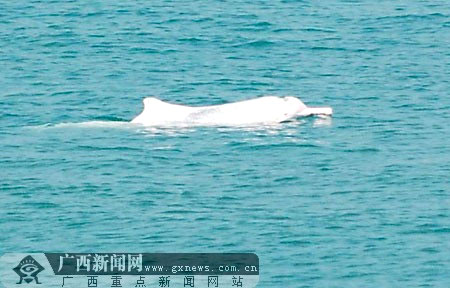The Chinese white dolphin spotted last Friday around a hydropower station in the Shunde district of Foshan, Guangdong Province, might have returned to the sea, officials and researchers said yesterday.
"We got reports from the local residents Friday morning and started tracking the dolphin that afternoon," Foshan Chief of Fishery Administration Xue Yongxiang said by phone. "But it disappeared on Saturday and we haven't gotten any more reports since then.
"But no news means good news sometimes. It might have returned to the place where it's supposed to be."
The visiting Chinese white dolphin was the first one reported in Shunde in the past 30 years, which was when records started being kept, according to the district's agriculture department.
The district is located along the Xijiang River - an extension of the Pearl River.
Witnesses said the dolphin, later estimated at about 1.8 meters long, performed several leaps in the power station's reservoir. The water acrobatics attracted dozens of passers-by.
The local agricultural authority, public security department and maritime authority issued warnings to the public to not threaten the rare dolphin by getting too close or trying to follow it in boats.
The Chinese white dolphins, which were classified in 1988 as an endangered wild species in China, usually live in the area where sea water and fresh water combine and provide an abundance of food, said Chen Xi, a researcher with the Pearl River Estuary Chinese White Dolphin National Natural Reserve.
The Pearl River estuary is home to about two-thirds of the dolphins found in Chinese waters. The Zhuhai-based natural reserve estimates their numbers in the estuary are between 1,000 and 1,200.
"The dolphin went farther into fresh water this time," Chen said by phone. "It can survive there, but cannot stay for a long time. It might get lost", which has happened in Foshan before.
In response to some media reports saying that the dolphin was forced to seek food in a cleaner fresh-water area due to the worsening pollution in the Pearl River estuary, Chen said there are no apparent signs in this case to draw such a conclusion.
"I am afraid I cannot agree (with those reports) without conducting an on-the-spot investigation," he said.
The deaths of 17 Chinese white dolphins were recorded in the natural reserve's 460 sq km between 2003 and 2006. The deaths have been attributed to pollution and maritime activities such as fishing.
Hong Kong figures indicate the number of dead dolphins found along the coast has gradually increased since 1995, with the annual average at about 10 now.
(China Daily HK Edition January 29, 2008)






